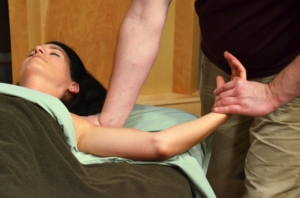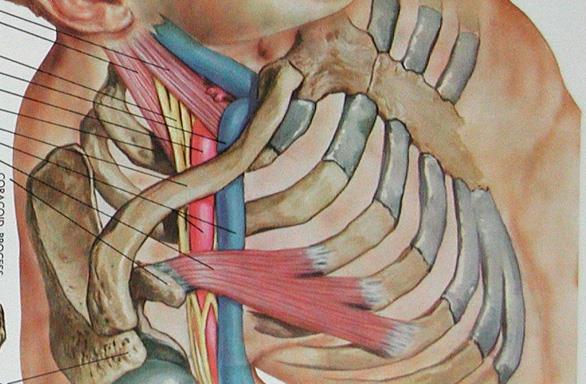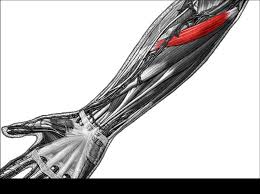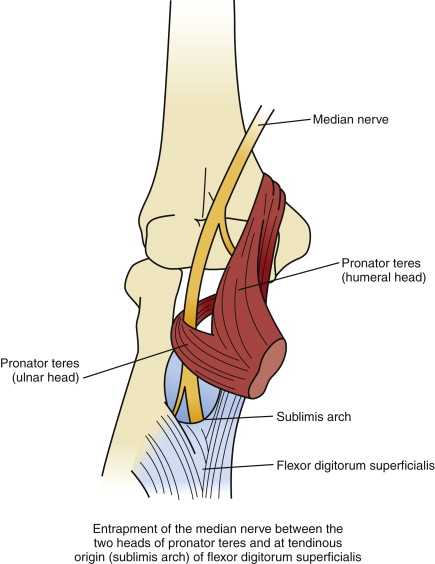
Pain in your wrist has caused you to have difficulty to type and work. You’ve found that you are starting to have difficulty to do things that you enjoy like cooking, writing, and even holding a cup of coffee. At night you wake up with numbness and tingling in your hand and it makes it difficult to sleep. You have tried using splints and other conservative measures and although they’ve helped a bit you still have pain, numbness, and tingling in your wrist and hand.
Massage may help with the pain of carpal tunnel syndrome in the short term and may help other long term treatments be more effective.
Massage therapy can best help carpal tunnel syndrome that is related to overuse of the muscles of the forearm and fingers. It may also help with other sites of nerve compression in the neck, shoulders, and arms that can also create symptoms similar to carpal tunnel syndrome.
What is Carpal Tunnel Syndrome and How Does it Develop?
Carpal tunnel syndrome is a compression of the median nerve in your wrist. The compression can be caused by anything that narrows the carpal tunnel and can be caused by conditions such as hypothyroidism, diabetes, and rheumatoid arthritis. Pregnancy can also be a cause of swelling in the wrist and create carpal tunnel syndrome.
Carpal tunnel Syndrome can also be caused by overuse of the muscles of the forearm and fingers. There are other sites in the neck, shoulders, and arms where the median nerve can be compressed that can create symptoms of carpal tunnel syndrome. Massage therapy goals are to reduce inflammation, reduce muscle tension, and reduce trigger point activity.

Carpal tunnel syndrome is caused by an impingement of the median nerve as it passes underneath the transverse carpal ligament. The muscles of the fingers and forearm also pass through the transverse carpal ligament. Therefore, overuse of the finger and forearm muscles can lead to an enlargement of these muscles and decrease the space in the carpal tunnel. This will lead to numbness, tingling, and pain in the palm surface of the thumb and first two fingers.
The carpal tunnel is made from the carpal ligament which forms a tunnel. The median nerve passes through the tunnel along with the flexor tendons which begin in the forearm.
The flexor tendons control the thumb and fingers and help move the fingers and grasp and hold objects. When the flexor tendons become overworked or develop trigger points this can inflame the tendons which will decrease the space in the tunnel and will compress the median nerve.
This will lead to symptoms of numbness, tingling, and pain in the palm surface of your hand, thumb, and first two fingers. When the diagnosis is carpal tunnel syndrome massage therapy may be very helpful to address the muscles of the fingers and thumb. The goal is to reduce inflammation, reduce muscle tension, and reduce trigger point activity.
However, the nerve begins in your neck and runs the entire course of your neck, arm, and forearm and can be compressed by various other structures in these areas. It is very important that a therapist perform a thorough physical assessment to locate other possible nerve entrapments. If the carpal tunnel is only treated without treating other sources of compression the problem may be very slow to resolve or minor symptoms may persist.
Nerve Root Impingement at C6-C7
The nerves that supply your arms and hands begins in your neck at the level of C6-C7 and is known as the brachial plexus. It travels from C5-C7 underneath your clavicle and down your arm becoming 3 different branches.

The brachial plexus exits the level of C-5 and C-7. Conditions such as herniated or bulging disc, spondylosis, or bone spurs can impinge the nerves as they exit the spine and create numbess, tingling, and pain in the arms and hands. Massage may help in tandem with other medical interventions for herniated or bulging discs and spondylosis. If bones spurs are impinging the nerve massage will not be helpful and will need medical intervention.
Herniated discs and spondylosis may impinge the nerve as it exits the spine. Massage is less likely to help directly with this but it may be helpful in tandem with other medical interventions as it helps with muscle spasms that may further irritate the nerves.
Compression of the Brachial Plexus By The Scalene Muscles, Clavicle, and Pectoralis Minor Muscle
The brachial plexus travels through a large muscle group in your neck known as the scalene muscles. Tight scalenes and trigger points in the scalenes can impinge your nerves and create pain, numbness, and tingling down your arm and hand mimicking symptoms of carpal tunnel syndrome. When the nerves are trapped by the scalenes it is known as anterior scalene syndrome. (Anterior Scalene test)
The nerves then travel underneath your clavicle. The nerves can be trapped underneath your clavicle when it is flipped up. This can be from muscles that control the clavicle. This is know as costoclavicular syndrome.
As the nerves continue their journey they pass through the pectoralis minor muscle. A tight pec minor muscle can also entrap the nerves creating pain, numbness, and tingling in the arms and hands also mimicking carpal tunnel syndrome. This is known as pec minor syndrome. ( SHow tests for p.m.s)
Massage therapy is indicated and can be very helpful for anterior scalene syndrome and pec minor syndrome as these are caused by tight muscles. The goal would be to reduce muscle tightness and trigger point activity, stretching, and restore postural alignment of the shoulder and neck.

The brachial plexus is shown in yellow and exits the levels of C-5 and C-7, passes through the scalene muscles, underneath the clavicle, and through the pec minor muscle
The pronator teres is another possible entrapment site of the nerve. The pronator teres is a muscle located at your elbow on the palm surface of your forearm. When this occurs it is known as pronator teres syndrome. Pronator teres syndrome can be caused by overuse of the muscle by activities such as rotating the forearm like using a screwdriver, racket sports, rowing, or weight lifting.

The pronator teres is shown in red. The pronator teres helps to rotate your forearem, as in if your palm is facing upwards it rotates your forearm so your palm is facing down. The pronator teres also helps to bend your elbow.

The median nerve passes through the two heads of the pronator teres muscle. Overuse of the pronator teres muscle can cause an enlargment of the muscle and compress the median nerve leading to symptoms similar to carpal tunnel syndrome.
 Matthew Snow is a Licensed Massage Therapist in Cos Cob, CT. If you would like to schedule or make an appointment call (203) 936-6379 or email hello@h2tmuscleclinic.com.
Matthew Snow is a Licensed Massage Therapist in Cos Cob, CT. If you would like to schedule or make an appointment call (203) 936-6379 or email hello@h2tmuscleclinic.com.

Leave A Comment